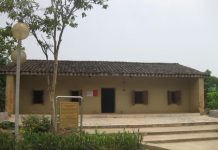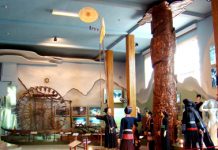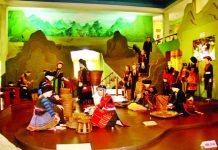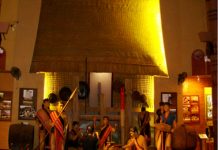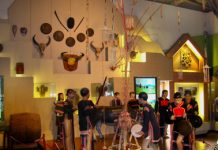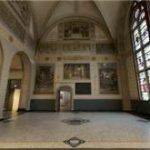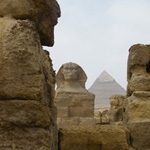|
In ancient history, these four ethnic groups had a common origin. Their ancestors were the owners of the Red River civilisation with their aged old wet-rice cultivation and a resplendently developed bronze age which was shown through famous archaeological sites such as Phùng Nguyên, Đồng Đậu, Gò Mun and Đông Sơn etc.
|
| Due to historical, natural and social conditions, Việt – Mường people was separated into different ethnic groups as at present.
The ethnic origin of Việt – Mường people led to some similarity in their languages, habits and customs. In addition, while people from different goups live together in an area, every of them can absorb the cultures of other groups and create each one’s specific character. In an area of 250m2, the showroom introduces the common and particular cultural elements of the four ethnic groups according to three areas: plain, valley and mountain. * Exhibition topic No. 1: VILLAGE GATE OF THE KINH PEOPLE. The Kinh live together in villages. Each village has a gate and is surrounded by bamboo hedges. Every village has a banyon tree, a well, a communal house and a pagoda to worship Buddha. A traditional village gate is made of bricks, on top of which there is a watch tower to prevent enemies. Communal house is built in the shape of the Chinese character “Ding” (person unit), “Kong” (work) or the shape of a mallet. Its back alter is for worshipping the village tutelary god, the vestibule is for communal activities. In the showroom there is the model of Thổ Hà Village gate, Việt Yên District, Bắc Giang Province. The gate was built in early years of the Christian Era. At first, it had a watch tower and door to prevent wild beasts and enemies. To the XX century, it was not a watch tower anymore. Apart from its function as “a door”, the village gate also demonstrates local character. * Village roads paved with slanting bricks of the Kinh Presently, many villages in the North Delta still have the roads paved with slanting bricks. This is the testimony of the traditional wedding custom of the Kinh in countryside in the northern Delta in early XX century. According to this custom, when marrying wife, the husband’s family had to offer the village a kind of “tax” to have a legal wedding. Many villages use this “tax” to do public works such as digging well, paving village roads and building village gate etc… Nowadays, this custom almost disappears and its vestige is the existing village roads or in the folk song – proverb: “Even you marry your wife with ten pigs, it is in vain without paying village tax… Marrying wife without paying village tax likes throwing money into a stream”. * Exhibition topic No. 2: ALTER WORSHIPPING ANCESTORS OF THE KINH The Kinh have had the custom of worshipping their ancestors since long time ago based on their beliefs of the immortal soul after death. Every year, people burn incense in death anniversaries, New Year, the first and fifteenth of lunar month to show their filial respect and reminiscence of the deceased, praying to the ancestors for blessing them with health, safety and prosperity. On the other hand, people make offerings to ancestors so that their spirits would not wander and cause negative disposition to their descendants. The way of worshipping ancestor depends on every family’s economic condition. In normal conditions, the alter is simple with only a wooden board attached to the wall and an incense-burner. In festival days, the first and fifteenth of lunar month sometimes only an incense, a plate of fruit or a cup of water on the alter are enough to show their filial feelings.For middle and wealthy families, the alters are pretty sophisticated with various worshipping objects. At the Museum, there is a model of a “three step”, red lacquerred and gold-trimmed alter with the carvings of “four supernatural creatures” of the family of Mr. Nguyễn Văn Tư, 52 years old – a middle Kinh family in Tư Village, Đồng Quang Commune, Tiên Sơn District, Bắc Ninh Province. At the back of the showroom is a worshipping dais, on which there is an ancestral tablet inside a box to worship the family’s ancestor. The tablet is inscribed with the ancestor’s name, alias, position, dates of birth and death. Next to it are a tube containing the family annals, lamps and candle stands on both sides. In the middle is a worshipping alter, on which there are a tray with fruit and foods in festival days, an incense burner to worship ancestors, lamps, cadle stands, three plates for water, betel and areca, wine and cigarettes. In front is an incense table, on which there are a set of three, five or seven bronze items, the three-items set include an incense urn and two cranes as candle stands. There are also two flower vases for flower offering in rituals and praying ancestors. Above the alter, on the beam and two house columns there are a horizontal lacquered board and wo parallel scrolls to show the descendants’ feelings towards their ancestors as well as the conditions of the family. Therefore, almost all the contents of the parallel sentences before the alter are the praising of the ancestors’ merits in doing good deeds for their descendants to enjoy good fortune and wealthy. However, the contents depend on the family’s literature or martial art talents. The insciption “Phúc lý tuy chi” on the horizontal lacquered board means: “Good luck for ever” and the two parallel scrolls “Thi thư tảo thức hương nhiên đức” and “Nhật nguyệt đồng ân phúc mãn đường” mean: “Early studying the Confucian books would disseminate the family’s fame of virtue” and “The family would be always full of the sun and moon light, and good luck for future generations”. These two scrolls show that the family has had a literature career through praising the ancestors’ benevolence and virtues and encouraging the descendants to follow this career. * Exhibition topic No. 3: WET RICE CULTIVATION AND FOOD PROCESSING OF THE KINH The Kinh has a very early tradition of wet rice cultivation. Through many generations, our ancestors had very good experience in cultivation as in the proverb: “Firstly water, secondly fertilizer, thirdly diligence, and fourthly the seeds”. They also built up a diligent and hard working agricultural people in the plain and middle land who unite to fight against natural disasters for a stable life and a humanitarian form of labour. Tools such as plough, harrow, hoe, spade, shovel hoe, bucket for water irrigation, sickle and reaping hook are exhibited at the Museum to show manual works in a farmer’s family: “Husband ploughing, wife transplanting and the buffalo harrowing” in a Kinh people’s village. The process of wet rice cultivation is not that simple. After transplanting rice seedlings, it is necessary to get rid of pests, weed, fertilize and often pay attention to water. After rice blossoming, farmers have to pray heaven for favourable weather to have a bumper crop. The processing of rice goes along with wet rice cultivation. In the 70s of the XX century, the processing was simple, using manual pounding and a rice huller (two parts of which are made of bamboo, stuffed with earth and wooden wedges) to husk rice. Every early morning or late in the evening, the rural women bustled about pounding and husking rice, and cooking meal for their whole families. Nowadays, few people can hear the noise of the rice huller and pounding in the countryside, because everywhere farmers use rice husker instead of human power and they have gradually adapted to industrial life. * Exhibition topic No. 4: the KINH’s fishery Living mainly in the plain, coastal area and river catchments, the Kinh know how to take full advantage of a coastal area of thousands of km and a dense river system for producing salt, fishery and aquaculture etc. Fishing is one of four main professions which bring about income for people living in coastal area, lagoons, lakes and rivers. Formerly, fishing equipment are mainly: shrimp net, trapping basket, casting net, net, and fishing trap etc…Nowadays, many fishermen have upgraded their fishing boats and used modern equipment for offshore fishing to enhance the output, in combination with coastal aquaculture. Together with fishing and making salt, people process aquaproducts, especially make fish sauce from different kinds of fish: anchovy, mullet, snake – head, codfish,… which are extracted in to liquid (sauce). There are four main steps in making fish sauce: prepare fish, mixing with salt, adding roasted rice flour and decanting fish sauce. People mix two or three portions of fish with one portion of salt then leave it for one year. The longer you conserve it, the bigger protein content is, but the less aromatic and darker it becomes. People also burry fish sauce for several years, then it becomes black and is called “nước mắm lú” and used for medicinal purposes. If you use spoiled and rotten fish, the processing period would be shorter, but the fish sauce would not have good smell. Fish sauce is classified according to its step of decantation (essence, class 1 and class 2 fish sauces). The use of fish sauce in every day meal is a peculiar feature of the Vietnamese gastronomy. * Exhibition topic No. 5: the MƯỜNG’s stilted house For many generations, the Mường have got used to live in stilted houses. They have summarized their cultural life in their saying: “Steamed rice, stilted house, shoulder-carried water, grilled pork, day in day out”. Mường’s house is often built on hills, back to the mountain. It has four roofs, three rooms and wooden floor. The first room at the stairs is the principal one. This is the room which is considered as gathering all supernatural power of the house and the place of all rites that show the people’s attitude to the house. At here, there is a main column bigger than other columns of the house for installing the acestor alter. Every people, including the owner or guests must not smear, put their back to, put their feet on, hang any things or their clothes on this column. Its part under the floor should not be used to tie buffalo, cow or hang labour tools. Anybody who violates one of these taboos would be considered outrageous to the family, its ancestors and god. Therefore the principal room is the place for men only and women are not allowed to rest or work here. In important days such as wedding and funeral, only influential men of the family can sit there for meal. In this sacred room, there is a window close to the floor called “voóng window”. In normal days, not any things or people are allowed to go through it and it is only used for bringing the coffin out in funeral. Opposite to the main column is another column which is also important. At the foot of this column is some bunches of rice without any seeds on them. On the column head is a holed basket symbolizing female nature and called nường (lady). Beside it, the Mường put a bamboo section torn into fibres at one side, symbolizing male nature and called nõ (prick). This shows the conception on balancing between yin and yang to create the stable development and harmony in the family. In this room, people also hang masks to keep souls for juvenile members of the family. The middle room is often for the rice store and kitchen. The final room is separated from other rooms in the house by a bamboo screen and is the place for cupboard, utensils, cooking meal and bed room for women. Mường’s stilted house has also the fourth place which is an inlaid floor made of wooden boards or big bamboos spanning the horizontal beams to store agricultural products and family utensils. The gable of Mường’s house always has a đuống and a round mortar. Đuống is a tool for crushing rice and also for giving signal when the family has some important event such as wedding or funeral. Apart from that, đuống Is also a percussion instrument of women for playing joyful musics in festive days or welcoming the guests to show their admiration. Under the floor is the place for production tools such as: plough, harrow, hoe, sickle etc…and keeping buffaloes and cows. At present, people do not put đuống and keep buffaloes and cows under the floor anymore. Mường stilted house in Hoà Bình often has two stairs which are called the owner’s stairs and the guests’ stairs. The owner’s stairs are in the final room for women only. The guests’ stairs are in the first room for guests and men only. This is quite different from the house with only one stairs of the Mường in Phú Thọ. The Mường in Phú Thọ think that the house with two stairs would bring about bad luck and poverty. That is why there are not any houses of this kind in this area. On the floor, every Mường’s house has two kitchens: one for the owner and the other for guests. The owner one inside is for cooking and heating. The guests’ kitchen is outside. In the Mường beliefs, the kitchen is very sacred in the flame itself. Therefore, it is a taboo to warm up the feet and change clothes at the cooking fire. The violation of this taboo means offending the fire god and would bring about calamities. Above the stove frame, the Mường install a smoking shelf to store processing and cooking utensils such as closely-woven basket for washing rice, salt jar, big flat chopsticks, baskets of different kinds, buffalo wooden tocsins etc… The Mường often say “If you want to find any things, go to smoking shelf.” The Mường’s gastronomy never miss out the unique flavour of wine drunk out of a jar through pipes. The wine is made from glutinous rice that is fermented with the aid of forest leaf yeast and used in festivals and rites such as: wedding, innauguration of a new house, funeral, reception of esteemed guests, rituals and New Year. A jar of good wine has many pipes for many people drink at the same time to show the solidarity of a community and the hospitality of the Mường people. * Exhibition topic No. 6: Cultures of the THỔ and CHỨT ethnic groups The Thổ live in the west of Nghệ An province with more than 50,000 people. They have different names: Kẹo, Mọi, Cuối, Họ and Đan Lai etc… They cultivate milpas in combination with wet rice field. Beside the cultivation by making holes for the seeds with a digging stick, they also use plough and harrow to cover the seeds after sowing. The Thổ have experience in fishing and hunting. They are good in weaving flax hammock for daily use. The Thổ live in mountainous villages along the rivers and big streams. Each village has from some to dozens of houses. Formerly, people lived in stilted houses, but now mostly live in ground houses. The living space in the Thổ’s house is divided into two parts: the outer part is for ancestors alter and receiving guests. The inner part is kitchen and place for women; under the floor is the place for keeping cattle and production tools such as hoe, sickle, fire wood and rice mortar. The stairs are often in the left gable. The Thổ do not weave fabric, so they mainly buy them or exchange with neighbouring ethnic groups. In some places, they wear like the Kinh living in countryside about half century ago, or buy skirts from the Thái people. However, the white turban and shirt made from coarse woven cloth are still the deep traditional character of this ethnic group. At present, the Chứt population is about two thousand people, living in Minh Hoá and Tuyên Hoá districts, Quảng Bình Province. The Chứt also has other names: Rục, Sách, A Rem and Mã Liềng. Their main means of existence are growing rice, cultivating burnt-over land, and also gathering, hunting, fishing and breeding. The Chứt do not grow cotton to weave fabric. Their attires mainly come from exchange with neighbouring ethnic groups. They wear blouse made from black cloth with slight embroidery on the laps, without buttons but tied by strings and a skirt with patterns like the ones of the Bru – Vân Kiều and people living beyond the border. Formerly the Chứt practiced shifting cultivation, living in caves, grottoes or rudimentary huts roofed with forest tree leaves. Today, they live a settled life in villages on mountain slopes. Their houses has one room and two wings like the one of the Kinh people in the northern part of Central Vietnam. * Exhibition topic No. 7: traditional handicraft * Pottery of the Kinh people The Kinh’s pottery has developed for a long time. Nowadays, many famous pottery villages still exist such as Bat Trang, Tho Ha and Hương Canh etc… with very diversified products including household commodities and decorative things (bowl, vase, tea pot, cup and animal puppets etc…) made from various materials such as terracotta, brown glazed terracotta and porous terracotta etc… Phù Lãng terracotta in Bắc Ninh was formed and developed in the Trần Dynasty in the XIV century. The technique is chiefly using a turning table and carved wooden or terracotta print blocks to create patterns and making bas-relief. The products of Phù Lãng pottery has brown enamel of various tints: eel skin, light yellow, dark yellow and brown yellow etc… and three main kinds: for religion use (incense burner, worshipping stand etc…); household things (jar, vase, pot, lime pot, hookah etc…) and decorative terracotta (vase and pot of animal shapes such as horse, elephant etc…). Bát Tràng pottery in Gia Lâm, Hanoi Hà Nội also came into being in the 14th – 15th centuries. The main material is clay; the traditional technique is using turning table. White clay is moulded and and dried, then covered with enamel and put into kiln. Today, mostly people use moulds to shape products. Traditional products of Bat Trang terracotta village include three kinds to serve religious or household use and decoration. Nowadays, the diversified products of Bat Trang terracotta are not only used inside the country but also exported to Europe, America, Japan, Republic of Korea and Taiwan. In November 2004, the trade name “Bat Trang – Viet Nam” was official published to advertise the aged-old terracotta of Vietnam on the world market. This event was an important step forward in the development of the Bat Trang terracotta village in the tendency of international integration. Hương Canh terracotta in Vĩnh Phúc since a long time has only served the local people requirements. The simple glazed terracotta pots are often used for containing agricultural products, salted egg plant, making shrimp paste and raising livestock etc… which diversify the Vietnamese cultural treasure. * Printing folk pictures in Đông Hồ At 30 km to the east of Hanoi, Đông Ho folk painting village in Song Ho Commune, Thuan Thanh District, Bac Ninh Province has been famous for printing picture since the XVI century. Đong Ho pictures are printed on a special kind of Dzo paper. The printing paper is made of bark of a tree called “Dzo”. Artists use pine leave brushes to coat Dzo paper with sea bivalve mollusk powder to create a sparkling colorful background. Colors of the painting are refined from various kinds of tree leaves, which people can easily find in VietNam. Traditional artists use all-natural colors for their pictures: burnt bamboo leaves for black, cajuput leaves for green, copper rust for blue, pine resin for amber, mountain pebble for red and crushed egg shells mixed with paste for white. The painting is covered by a layer of sticky rice paste to protect the painting and their colors. Painting tools are only frames, printing woodblocks and brushes. Each colour has its own carved woodblock. Therefore the number of colour in a picture means the number of woodblocks ued to make it. There are five kinds of pictures: workshipping, historical, wishing good lucks, daily activities and stories.The painters has produced hundreds of famous works such as the romantic and humorous “Catching coconuts” and “Jealousy scene.” “Catching coconuts” praises a happy family with harmonious wife and husband and their two children playing joyfully. “It is so clever to set up a coconut tree on which a husband climbs and a wife catches the falling coconuts as a harmonious couple.” On the contrary, “Jealousy scene” is satirizing the polygamous system. The unfaithful husband makes the home shattered and its members gone. “Please subdue your anger, or you would bring shame to me and yourself.” Đông Hồ pictures have a long standing life and special attraction to many Vietnamese generations as well as foreign visitors thanks to their topics full of folk characteristics which are plain, simple and close to Vietnamese culture. Đong Ho artisans such as Nguyen Huu Sam and Nguyen Đang Che have contributed much to preserve the printing career and are the owners of the pictures being exhibited at the Museum today. * Đại Bái Village of forging brass Đai Bai, formerly named Van Lang, a well known village of traditional brass forging is specialized in making household things. At first, Đại Bái only made rudimentary utensils, then water pot, tray and wash-basin. By early XI century, the vocation of forging bronze in Đại Bái Village developed strongly. Its most famous products are: bronze statue, incense holder, incense burner, flower vase, picture and parallel scrolls. Tools for forging include bellow, pot, mould, anvil, hammer, brass-cutting scissors and lathe. Nowadays, Đại Bái Village continues to develop and preserve its traditional vocation through big cooperatives, private enterprises and technical improvements with self equiped and manufactured machines such as roller, stamping machine, polisher etc. and finding markets for export. * Exhibition topic No. 8: folk music The Kinh’s musical instruments include tocsin, castanets, two cord fiddle, clarinet etc., in which tocsin is an instrument echoing by itself and popular in Viet Nam. It is used in different cases with various functions. In a pagoda, it beats time for reciting Buddhist scripture. In daily life, farmers in the old time used tocsin to beat time and perform music in classical drama and popular opera. Today, it is also used in folk music. Xinh tiền is an unique percussion instrument which appeared in Viet Nam at least some hundreds years ago. Its ancient name is phách xâu tiền or phách quán tiền (percussion with string of coins). At present, it is also called sênh tiền (or xinh tiền). Xinh tiền is used in royal orchestra, an octet, sắc bùa singing, ả đào singing or concert performing, beating time or dancing properties. Xinh tiền includes three hard wooden pieces, two of which are 28cm long, 3cm wide and 8mm thick, while the third one is only 20cm long. The Mường have a gong set cast in brass or bronze. Gongs appear in all festivals, rituals and communal activities of the Mường such as: rituals of getting down to the rice field, praying for rain, rituals of new rice and welcoming new house, fishing festival and funeral etc… Gongs are also used in hunting, alarm when there is a fire and thief, informing the orders of the village chief. Especially in Lunar New Year, the Mường organise Sắc bùa singing to wish a Happy New Year to families in village. The melody of sắc bùa singing and the people’s humanitarian attitudes have created specific and unique features in Mường culture. A Mường’s complete gong set should has 12 pieces. Gong players are often women, but sometimes both men and women. Each person takes the gong’s handle in one hand, and a wooden stick wrapped in cloth in the other hand and strikes the gong knob to the rhythm. A Mường’s gong ensemble has two forms of performance: standing in a row at a place, or both striking the gongs and going round. Formerly, when there was an important event in the village, the noble families – the village head often had several gong troups played at the same time. * The Kinh’s art of water puppetry Water puppet is a form of aged-old traditional folk theatrical art of Viet Nam, closely attached to festivals in villages. The art of water puppetry came into existence nearly 10 centuries ago. Traditional water puppetry has rich and brief contents, truly reflecting the life of production and struggle against natural disasters and enemies in order to adapt to nature, build the life and protect the country. In earlier times, puppet show was performed without words or with only introduction, background singing and explanation together with the sounds of drum, tocsin, fire crackers, horn and beating time to create a boisterous atmosphere. The puppets are made from fig wood, coated with raisin, then painted with gold or silver gilding. A water puppet can move with the help of two kinds of hidden springs and strings and perform by poles and string. Water puppet performance is often opened with the introduction by character Chú Tễu to create joyful and humorous atmosphere imbued with folk characteristics. Then comes the performance of four supernatural animals (dragon, unicorn, tortois and phoenix) to show the wish for favourable weather and a bumper crop; The plays express daily life such as rice husking and pounding, ploughing, fox catches duck etc… The water puppet plays praise the deligent and kind farmers, criticise the braggart and dishonest people, bringing the day-to-day life onto the stage, thus diversify the Vietnamese cultural treasure. * Exhibition topic No. 9: folk opera on a mat in san đinh (yard of the Village Communal House). Chèo (Folk opera) is a form of art imbued with national identity. It originated from the villages of the Red River Delta. Starting with the folk plays of parody and comedy in the X-XI centuries, Chèo has gradually become a cultural activity of many villages in the North of Vietnam. Formerly, the stage of Chèo is two mats in the center of sân đình (yard of the Village Communal House). The audience sit in three sides, so it is called chiếu chèo (chèo mat) or chèo sân đình. By early of the 20th century, chèo was put onto the stage and became a typical Vietnamese traditional theater. * Exhibition topic No. 10: village communal house of the KINH Communal house is closely related to the Kinh’s worshipping of village tutelary god. Every year, rituals and festivals are often organised at the communal house. Rituals and festivals are attached to historical traditions (legends on the gods fighting the enemies, founding the village and teaching vocations), and agricultural rites (rite of water procession). The famous village communal houses in the North are: Đình Bảng in Bắc Ninh; Đình Bát Tràng in Gia Lâm District, Hà Nội, Đình Tây Đằng in Chu Quyến – Hà Tây; Đình Thổ Hà in Phù Lão – Bắc Giang; and Đình Hoành Sơn in Nam Đàn, Nghệ An. The Museum has a model of a part of Đình Bảng, the biggest communal house of Vietnam in Đình Bảng Village (formerly Cổ Pháp Village), Từ Sơn District, Bắc Ninh Province. It was built in the end of the 18th century with four roofs. Some communal houses have eight roofs according to architecture in the shape of Chinese character “đinh” (number of person) to worship village tutelary gods such as Cao Sơn Đại vương (Mountain God), Thủy Bá Đại vương (Water God) and Bách Lệ Đại vương (Land God), as well as six persons who were credited with the founding of the village in the 15th century. Today, communal house still plays an important role in Vietnamese people’s life and feelings. From generation to generation, the people have always preserved and respected the communal house – an indispensable part of Vietnamese culture. * Exhibition topic No. 11: QUAN Ho singing in KINH BaC Kinh Bắc is the cradle of many special traditional festivals and homeland of quan họ folk songs. When spring comes, quan họ singing festival is held in villages. Before the festival, people bring incense, flowers and offerings to Vua Bà (Queen) Temple in Viêm Xá Village, Yên Phong District, Bắc Ninh Province to ask permission for organising festival. Legend has it that Vua Bà was the composer of quan họ songs. When singing quan họ, men often wear the (gauze) or silk long dress and turban, and handle an umbrella. Women wear three or seven flap dress with pink silk waist band and nón quai thao (flat hat), thus look more graceful. Quan họ singing is a kind of repartee between male and female singers. The songs originate from daily life, are imbued with lyric character, very methodical and rich in melody. The place of quan họ singing festival may be inside a house, yard of communal house or pagoda, on a river or a hill. Quan họ singing always has a scene of greeting exchange, inviting betel chewing, and exchange about family situations. Every festival sometimes lasts for 2-3 days, then the singers make an appointment of meeting in the next year festival. * Exhibition topic No. 12: box containing gifts in a wedding of the KINH people Lacquered box containing gifts is a must in a betrothal ceremony of the Kinh. The quantity of gifts depends on every family conditions. People use 3 – 5 – 7 boxes with different sizes. In general, when the couple agree, it is necessary to carry out the marriage proposal rite, then both families pick a good day for a betrothal ceremony. In this ceremony, unmarried boys carry lacquered boxes of gifts including areca nuts and betel leaves, tea, cake, fruits, wines etc… Each box covered with a red cloth embroidered or painted with a Chinese character “Double Happiness”. Depending on the number of boys carrying boxes, the bride’s family has had an equivalent number of unmarried girls to receive the boxes. The bridegroom’s family open these boxes, then a representative of the bride’s family receives them to put on the family’s ancestor alter. Two families discuss the wedding plan and have a party. When the bridegroom family leave for their home, the bride’s family leave on a the cover of a box a part of the gifts called lại quả (returned gifts). At present, the betrothal ceremony and lacquered boxes of gifts are still maintained in people’s customs. Many families even organise very big betrothal ceremony with 9, 12 or 15… boxes of gifts. * The custom of chewing betel: The knife, cloth bag, lime pot and betel tray exhibited at the Museum show the custom of chewing betel and humanitarian behaviour of the Vietnamese; chewing betel has been an aged-old tradition of many ethnic groups in VietNam since the Hùng King time. It is closely related to a folk tale about the love and loyalty. Therefore, betel leaves and areca nuts manifest both the manners and feelings of the Vietnamese. “The betel begins the conversation”, making people closer and more open-hearted to one another. Betel is used in festivals, songs, receiving guests, gifts in betrothal ceremony, replacing the cards for wedding invitation. Betel leaves and areca nuts exist in happy or sad events in the countryside, as a gift in Lunar New Year. They are also offerings in rituals and death anniversaries to memorise the predecessors’ merits of giving birth and feeding. Chewing betel is also attached to the practice of dying teeth to have “red cheeks and black teeth” which are typical for the beauty of ancient girls. |
Home
Introduction
Display system SHOWROOM No. 1 CULTURES OF ETHNIC GROUPS OF VIỆT – MƯỜNG LANGUAGE...









